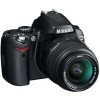- Qualcomm Launches Snapdragon 4 Gen 2 Mobile Platform
- AMD Launches Ryzen PRO 7000 Series Mobile & Desktop Platform
- Intel Launches Sleek Single-Slot Arc Pro A60 Workstation Graphics Card
- NVIDIA Announces Latest Ada Lovelace Additions: GeForce RTX 4060 Ti & RTX 4060
- Maxon Redshift With AMD Radeon GPU Rendering Support Now Available
Nikon D40x 10.2MP Digital-SLR Camera

Up until recently, Nikon’s line-up has had many gaps. This past March though, they released their P5000 advanced point-and-shoot camera alongside their D40x D-SLR. Today we are taking a look at the latter, which turns out to be a fantastic offering for those looking to take the plunge into high-quality photography.
Page 1 – Introduction
|
|
Last November, Nikon made an announcement that both delighted some and confused many. The D40 was set out to replace the D50, but not replace it at the same time. Though both cameras had comparable sensors, the D50 was a larger camera, and more comfortable to use overall. However, a few of the pluses on the D40 made many D50-owners consider an “upgrade”.
So the D40 came and had a certain amount of success, although I am not sure about exact numbers. What it brought to the table was a smaller frame, in effect becoming more lightweight than the D50 and other Nikon D-SLRs. Despite its ‘value’ moniker, it was equipped with a 6.1 megapixel sensor capable of 2.5FPS for up to 100 shots of JPEG fine. Indeed, it was a performance camera, regardless of it’s price.
Fast forward to this past March, when Nikon announced their follow-up, the D40x, which we are taking a look at today. People world-wide yelled, “what the?” and for good reason. How was it that Nikon could possibly release an upgrade for a camera that was out for less than five months?
Simple answer: They didn’t. Sure, the D40x shares the same name, but it was targeted more towards the advanced beginner, whereas the D40 was more for the absolute beginner. That said though, any D-SLR can be well-handled by a beginner, it’s just that the D40/x are both designed more towards the novice, thanks to its design and revamped user-interface.
Both the D40 and D40x cannot be compared. The original D40 sells for $525 on average, which includes the updated 18-55mm f/3.5-5.6G II ED AF-S DX Zoom-Nikkor lens, while the D40x without lens retails for an average of $630. So there is a $180 – $200 premium for the D40x, which can be justified a variety of ways:
First, the D40x offers a sensor similar to what’s found in the D80, so it’s capable of 10.2 megapixel images at 3FPS also with a burst rate of up to 100 shots of JPEG fine. In addition, it offers ISO sensitivity as low as 100, while the original D40 cannot go below 200, similar to the D50. Like the original, it offers three focus-points, which I consider to be one of the few downsides of the camera, although some may disagree with it’s overall value. Between both the D40x and D80 though, the number of focus-points is the biggest noticeable difference when shooting, besides the obvious size difference, of course.

Both the D40 and D40x use a standard F-mount lens support, which lacks the mechanical focus drive pin. Thanks to this, auto-focus will only function properly with AF-S and AF-I lenses. This could be considered another downside, but the selection of compatible lenses is absolutely huge, and you are unlikely to acquire, or want, a lens that is incompatible.
When the time comes to purchase your D40x, chances are it will include either the 18-55mm II lens, or the 18-135mm which was originally launched alongside the D80. Both lenses offer similar quality, but are entirely different in build. The 18-135mm is far bulkier, while the 18-55mm II is small… and cute. I realize my manly status has suddenly decreased, but it’s entirely true. You cannot go wrong with either lens, but the 18-135mm will treat you better if you are looking for a long zoom at a budget price.
Also launched with the D40x is Nikon’s own 55-200mm f/4-5.6 VR lens, which is a rather sweet deal at ~$250. With this lens, you could afford to use the 18-55mm and switch to the 55-200mm only when you require it. Note that 55-200mm is not a lens you will use indoors, given the base focal range, but if you are heading outside, it would suffice as being your primary lens. For close-up shots, you would just require to stand back a little bit further than you would with the 18-55mm.
Last of the accessories you will want to consider is the SB-400 speedlight that was released with the original D40. It currently retails for ~$100 and is a great starter-speedlight, but if you can splurge, I’d highly recommend stepping up to the more capable SB-600 which retails for ~$180. The primary differences are easy tweaking and the ability to swivel it around.
After all said and done, if you want to have a complete kit to get yourself started, which would include the camera, 18-55mm lens and SB-600 speedlight, it will cost around ~$930USD before taxes. Replace the 18-55mm with the larger 18-135mm and it will cost $1,100USD before taxes. Personally, I would choose the latter simply because the lens has a more capable zoom, but if you are not concerned with zooming in, the 18-55mm will certainly suffice. The smaller lens will also keep the overall cameras weight down, ideal for women and children.
|
|
Support our efforts! With ad revenue at an all-time low for written websites, we're relying more than ever on reader support to help us continue putting so much effort into this type of content. You can support us by becoming a Patron, or by using our Amazon shopping affiliate links listed through our articles. Thanks for your support!





